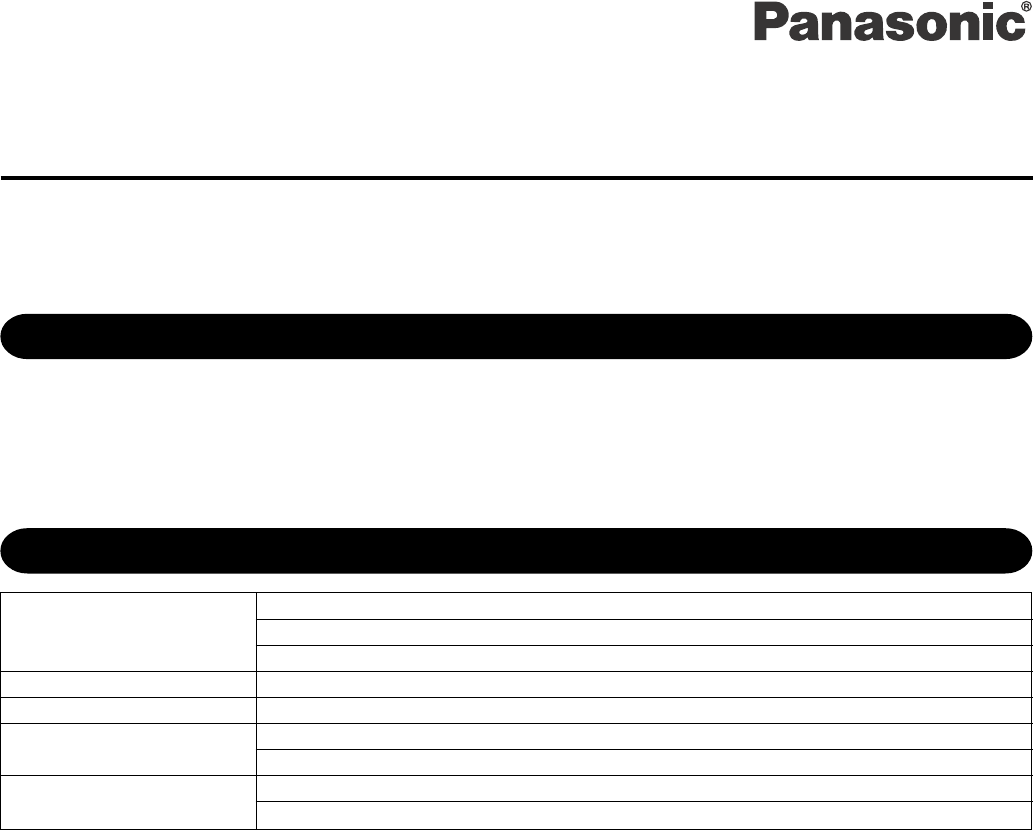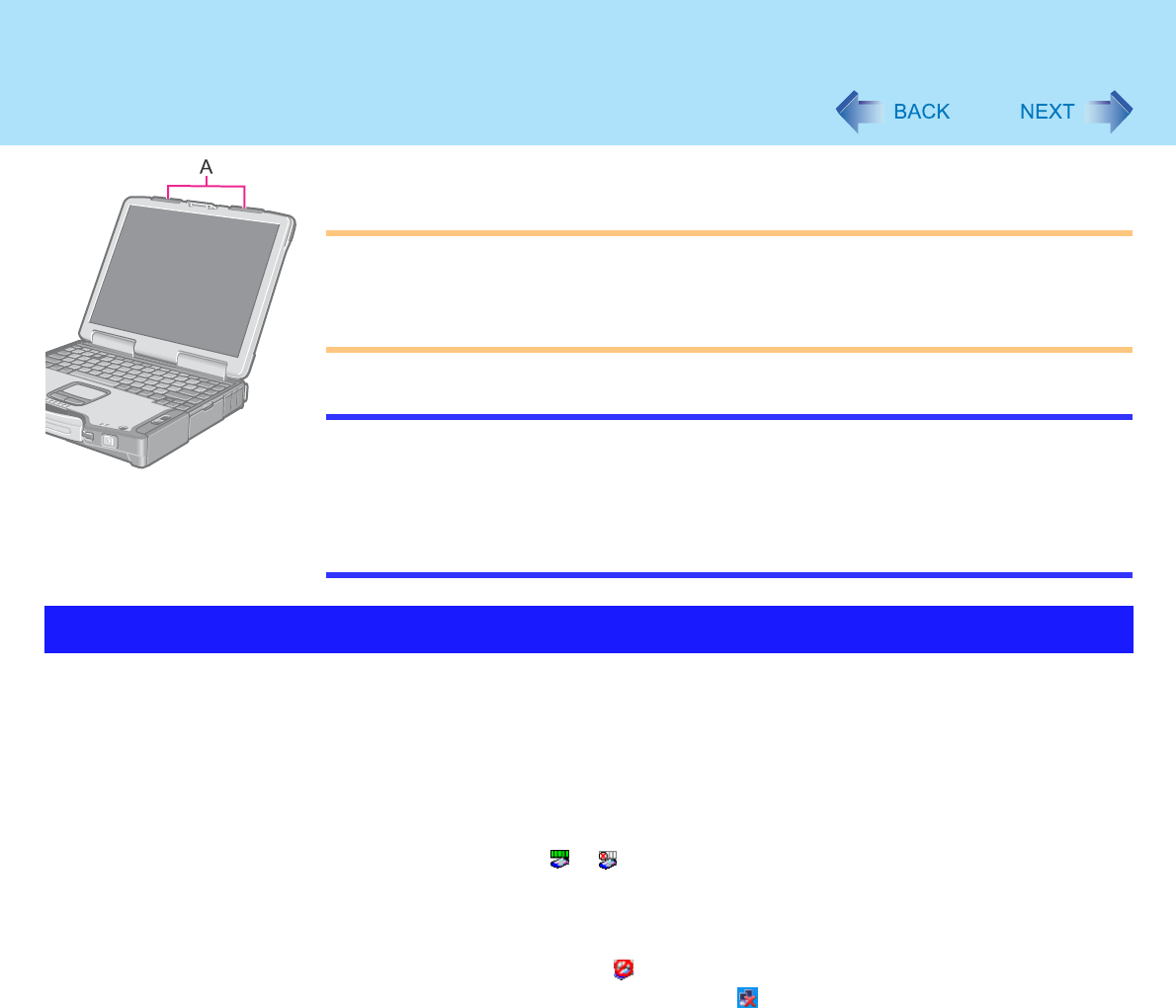Panasonic of North America 9TGCF-299A Panasonic Notebook w/ Intel WLAN & Sony PCMCIA User Manual WLANbg 50 T2 W2 Y2 a p65
Panasonic Corporation of North America Panasonic Notebook w/ Intel WLAN & Sony PCMCIA WLANbg 50 T2 W2 Y2 a p65
Contents
- 1. Users Manual
- 2. Supplemental Users Manual for PCMCIA
- 3. Sony Users Manual
- 4. Supplemental Users Manual for WLAN
- 5. Supplemental Users Manual for UNII
Supplemental Users Manual for UNII

This manual contains supplementary instructions regarding the use of the computer. It explains the cases where the operation of the
computer differs from that in the Operating Instructions.
Your computer is equipped with Wireless LAN enabling you to communicate using radio frequencies.
Supplementary Instructions
for Wireless LAN
FCC Radio Frequency Interference Requirements
This product is restricted to indoor use due to its operation in the 5.15 to 5.25 GHz frequency range.
FCC requires this product to be used indoors for the frequency range 5.15 to 5.25 GHz to reduce the potential for harmful interference
to co-channel Mobile Satellite systems.
High power radars are allocated as primary users of the 5.25 to 5.35 GHz and 5.65 to 5.85 GHz bands. These radar stations can
cause interference with and /or damage this product.
Specifications
Data transfer rates
Standards supported
Transmission method
Wireless channels used
RF frequency band
IEEE802.11a: 54/48/36/24/18/12/9/6Mbps (automatically switched)
IEEE802.11g: 54/48/36/24/18/12/9/6Mbps (automatically switched)
IEEE802.11b: 11/5.5/2/1 Mbps
IEEE802.11a/IEEE802.11g/IEEE802.11b
OFDM system, DSSS system
IEEE802.11a: Channels 36 to 64, 149 to 165
IEEE802.11b/IEEE802.11g: Channels 1 to 11
IEEE802.11a: 5.18~5.32GHz, 5.745~5.825GHz
IEEE802.11g/IEEE802.11b: 2412~2462MHz

76
Wireless LAN
If you use a wireless LAN, you can use a network without cable connections.
CAUTION
Communication is performed through the wireless LAN antenna (A). Do not block the
antenna area with your hand or otherwise interfere with the passage of the radio
signals.
Do not use the Fast User Switching function. The wireless LAN cannot be used.
NOTE
The communication speeds and distances differ depending on the devices that
support the wireless LAN, the installation environment and other ambient conditions.
One characteristic of radio waves is that their transmission rate tends to drop as the
communication distance increases. It is recommended that the devices supporting
the wireless LAN be used in close vicinity to each other.
The rate may drop while a microwave oven is being used.
Do not use wireless LAN on airplanes, in hospitals, or in other
locations where wireless LAN signals may affect the operation
of devices in the vicinity.
If you intend to use the computer in the environments described above, turn the wireless
LAN off using the following method:
ADouble-click or on the taskbar.
BSelect your wireless LAN adaptor and select [General].
CSelect [Off] for [Switch radio].
DSelect [OK].
The icon will turn to .
• Do not select [Disable] using with the right button located on the
taskbar.
Precautions

77
Wireless LAN
To prevent theft of data or unauthorized access to the hard disk
via a wireless LAN.
If you plan to use wireless LAN functions, we recommend that you do so only after
making the appropriate security settings, such as for data encryption.
We recommend turning the wireless LAN off when it is not used
or out of range (page 76).
If you leave the wireless LAN on, the battery's operating time is shortened.
To use the wireless LAN, set the profile using the following procedure.
The settings will vary for different network environments depending on the network system
being used. For more details, ask your system administrator or the person in charge of the
network.
CAUTION
Set profiles for each user using the following procedure.
1Double-click on the taskbar.
2Select your wireless LAN adapter and select [General].
3Select [On] for [Switch radio].
4Select [Networks] and select [Add].
5Enter the profile name and network name (SSID), and then make
other necessary changes, then select [Next].
6Make necessary changes and select [Finish].
For security, we recommend that you enable encryption (WEP). If you enable
WEP, enable encryption on the access point side as well. (The setting described
The Settings

78
Wireless LAN
below is only an example. For the other settings, ask your system administrator
or the person in charge of the network.)
ASelect [64-bit] or [128-bit] from [Encryption Level].
BSelect [Use pass phrase] or [Use hex key], and input the pass phrase or key.
In the case of ASCII character: [64-bit (5 characters)] [128-bit (13 characters)] .
In the case of hexadecimal: [64-bit (10 digits)] [128-bit (26 digits)].
• Set the same values for the computer side and the access point side.
• When using an access point for which "128-bit" can be set (some access
points display "104-bit"), we recommend setting data encryption to "128-
bit" to prevent unauthorized decryption.
7Select the profile you have set and select [Connect].
If the setting of the profile that is currently connected is changed, the new setting
will not be enabled until you select the profile and then select [Connect].
8Select [OK].
Open the Intel PROSet using either of the following procedures.
Select [start] - [All Programs] - [Intel Network Adapters] - [Intel(R) PROSet for Wireless].
Double-click or on the taskbar to check the communication status.
For more information about how to use the Intel PROSet, refer to [Help] in the menu bar.
If the function fails to operate correctly
Read the operating instructions for the access point carefully and check the settings.
The access point fails to be displayed in [Available Networks]
Select [Networks], then select the profile you are using, and select [Advanced]. [Connect
to ad hoc networks only] may have been selected in [Connection preference]. In this
case, select [Connect to infrastructure and ad hoc networks].
This computer uses channels 1 through 11*1. Check the channel being used by the
access point.
Check the Communication Status

79
Wireless LAN
*1 In the case of wireless communications, the frequency band being used can be divided into
segments, so that different communications can be conducted on each band segment. A "Channel"
refers to the individual frequency bandwidth divisions.
The access point cannot be accessed
The network key setting may not conform to the access point.
Check the network key setting of the access point and, if necessary, set it again correctly.
Depending on the access point and settings, access may not be accepted unless the
computer's MAC address is registered beforehand. In this case, check the computer's
MAC address using the following procedure and register it according to the operating
instructions of the access point.
ADisplay [Command Prompt].
Select [start] - [All Programs] - [Accessories] - [Command Prompt].
BInput [ipconfig /all], and press
Enter
.
CMake a note of the 12-digit string of alphanumerics displayed on the wireless
LAN's "Physical Address" line. Then input [exit], and press
Enter
.
The IP address of the access point is wrong
Following the operating instructions of the access point, set the IP address of the access
point again correctly.